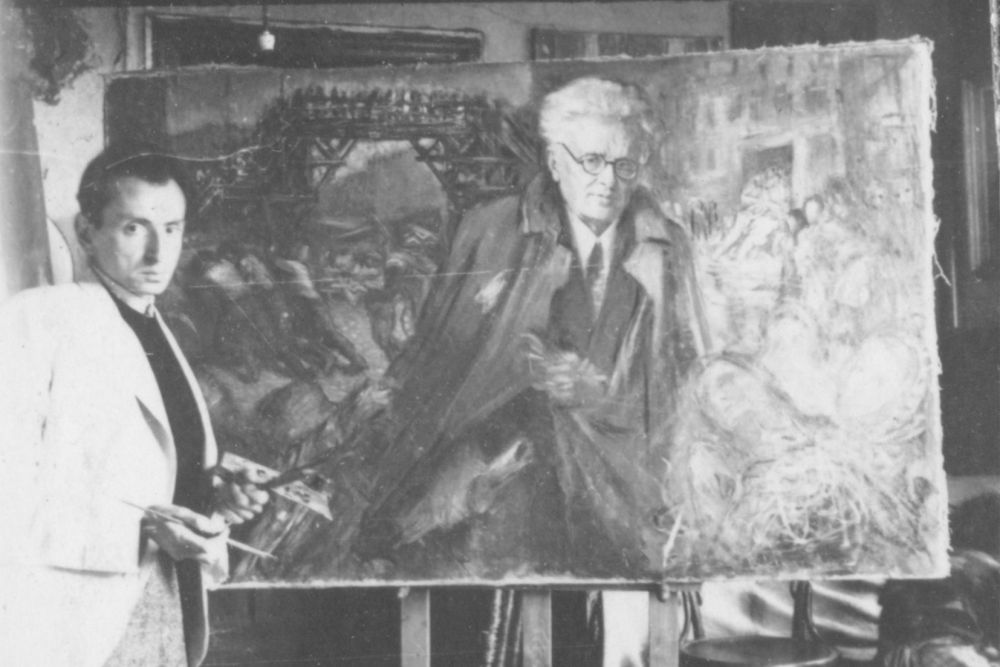- News
- Events
- Oneg Shabbat
- Collections
- Research
- Exhibitions
- Education
- Publishing Department
- Genealogy
- About the Institute
- Bookstore


Izrael Lejzerowicz at work (1941), The State Archive in Lodz
Izrael Lejzerowicz is one of the best-known among the painters active in the Łódź ghetto. The Jewish Historical Institute holds the largest collection of his original sketches and paintings from that period. Some of them reflect the gradual annihilation of the closed Jewish quarter in Łódź. A total of 45,000 of its residents died of hunger and diseases.
During the tour of the exhibition “Capturing the Ghetto. Artistic Portrayals of Everyday Life in the Łódź Ghetto” on February 2, 2025, Dr Agnieszka Żółkiewska showed several of Lejzerowicz’s apocalyptic works. She also gave the long-awaited answer to the conundrum surrounding a painting depicting Chaim Rumkowski in front of the wooden footbridge over Zgierska Street, right next to the Church of the Assumption of the Blessed Virgin Mary.
The scholar has managed to establish that the piece was of one of two nearly identical portraits of the Judenrat chairman in the Łódź ghetto produced by Lejzerowicz. The first was commissioned by Rumkowski himself at the turn of 1940 and 1941. A photo showing Lejzerowicz working on the painting has been preserved. It is a canvas of a considerable size, depicting Rumkowski against the background of the ghetto’s panorama.
![02687-S.JPG [97.36 KB]](/storage/image/core_files/2025/1/31/48a1bdfb49733ab7172931dd8caf6914/JPG/jhi/preview/02687-S.JPG)
Lejzerowicz never finished painting the background. The general public eventually saw the painting in a stripped-down version, showing only the figure of Rumkowski. It came to be printed on the ghetto calendar for the year 1942 and included in the design of a postage stamp issued in the ghetto at the time. The original work, meanwhile, hung on the wall of the Judenrat chairman’s office, as confirmed by a surviving photograph.
![MŻIH B-361_1-2_1.jpg [285.72 KB]](/storage/image/core_files/2025/1/31/688153b33eb709a6f440d5464a6c5c99/jpg/jhi/preview/MŻIH%20B-361_1-2_1.jpg)
The second, seemingly identical painting – the one displayed at the exhibition in the JHI – was probably produced a bit later. It constitutes an apocalyptic counterpart to the piece commissioned by Rumkowski. It has a muted colour palette, almost completely deprived of light, with a dynamic composition showing human figures frozen in motion. They are headed towards death, with their demise palpable.
The artist included his self-portrait in the painting. On the left side of the canvas, there is a woman with a face closely resembling Lejzerowicz. The figure has a rickety, skeletal silhouette. She is wrapped in a translucent, rusty red shawl. Or is it just an illusion, and it is actually a bloody halo? What is certain is that the woman is a personification of death, the Grim Reaper. Another figure, until recently erroneously believed to represent Lejzerowicz, is probably Oskar Rosenfeld, the painter’s friend and one of the authors of the “Ghetto Chronicle”.
![MŻIH A-163_1.jpg [564.24 KB]](/storage/image/core_files/2025/1/31/ee4cce8c0abc09ce00b427278bc44612/jpg/jhi/preview/MŻIH%20A-163_1.jpg)
There are many more mysteries and riddles hidden in Lejzerowicz’s paintings from the ghetto – Dr Agnieszka Żółkiewska discusses them in her upcoming article.